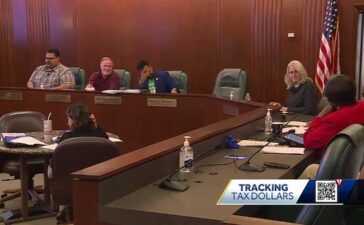The era of ESSER—the three rounds of federal pandemic-relief aid for K-12 schools totaling more than $190 billion—is coming to a close. But for some districts, spending the remaining dollars may come down to the wire.
Only six months remain for districts to commit all their federal COVID-relief dollars to specific expenses by the Sept. 30 deadline. Then districts have another four months—until Jan. 31, 2025—to “liquidate,” or spend those funds, unless they apply for a deadline extension for more time to spend the money on contract expenses.
The Edunomics Lab, a school finance research group based at Georgetown University, maintains the most up-to-date, publicly available data on ESSER spending, drawing from state dashboards.
Most districts, according to the Edunomics database and surveys conducted by the EdWeek Research Center, have spent the vast majority of their remaining funds or have concrete plans to do so.
But the Edunomics tracker currently shows more than 450 school districts, out of the nation’s 13,000, have spent fewer than 10 percent of ESSER III dollars. The Center on Budget and Policy Priorities, a progressive think tank, highlighted those districts in a recent report, urging them to make use of the money before it’s too late.
Education Week contacted more than two dozen of those districts and received responses from sevenhows. All but one said they’ve actually spent a much larger share of their remaining federal emergency funds than what the publicly available data show.
Any dollars districts don’t commit and spend by the deadlines will go back to the U.S. Treasury.
Less than 1 percent of ESSER I, the first and smallest of the three rounds of emergency funds, went unspent.
An exact figure for unspent ESSER II figures wasn’t yet available at press time, because the federal government appears to still be processing requests from states to grant districts deadline extensions on contract spending. The U.S. department of Education and the Treasury didn’t respond to multiple requests for comment in time for publication.
But Marguerite Roza, the director of the Edunomics Lab, said the number is no higher than $662 million—the amount states reported districts hadn’t spent as of the ESSER II liquidation deadline.
That means the maximum amount of unspent ESSER II money is slightly more than 1 percent of the $54 billion Congress allocated in December 2020. Some of those dollars will likely go toward contract expenses that districts will get permission to pay after the deadline, so the amount of money that goes back to the Treasury will likely be less than $662 million.
If districts were to collectively send back 1 percent of ESSER III dollars once the deadline passes, they would be returning $1.2 billion, or $24 for each of the nation’s 50 million K-12 students.
All told, schools have spent or will spend the overwhelming majority of federal funds geared toward helping them recover from the pandemic.
Still, even districts with the best intentions may fall short of spending everything in time, and even a small amount of unspent money could have paid for something worthwhile.
“If I were a teacher, I’d be like, ‘If you’re sending back $5,000, I could have done something with that,’” Roza said.
Here’s a look at the reasons why some districts appear to be lagging behind on ESSER spending—and some risk factors district leaders should anticipate as they wrap up the ESSER era.
Districts haven’t requested reimbursement yet
In order to liquidate ESSER funds, districts typically pay for their desired items out of their own budgets and then request reimbursement from their state education department, which refunds them out of the bucket of federal funds.
District processes for submitting requests for reimbursement vary considerably, which means databases like the one Edunomics maintains won’t immediately show all the money that’s been spent.
For instance, according to the Edunomics database, the Lake Ridge New Tech schools in Gary, Ind., haven’t spent a penny of the nearly $9 million they received for ESSER III.
In reality, the district has spent millions of dollars on salaries and benefits for academic and behavior interventionists but has yet to request reimbursement, said Adrian Wilkerson, the district’s business manager and chief financial officer.
The district plans to submit reimbursement requests to the state in the next couple months so those expenses show up in data reporting, Wilkerson said. Even so, his contacts at the state education department have pressed him at times over whether his district has a plan to spend all its money in time.
“We’ve tried to keep them up to date, but they sometimes get kind of locked into their dashboards and the numbers they have in front of them,” Wilkerson said.
Tip: Roza recommends districts submit reimbursement requests as soon as possible. Some state education departments may run out of their own ESSER funds that have been paying salaries for staff members who process those requests. Waiting until right before the deadline risks an administrative hiccup with disastrous consequences, particularly if the department rejects any requests. And the sooner those requests are in, the quicker accurate information about district spending will be available to the public.
Some planned expenses haven’t played out yet
The Riverdale school district in Illinois has an addition and security improvements planned for its elementary school, said T.J. Bull-Welch, the 1,000-student district’s business manager.
The Oxford Hills school district in Maine will liquidate $1 million soon to pay for the construction of an outdoor learning pavilion, which is still underway, said Carrie Colley, the director of finance and operations for the 3,000-student district.
And Wilkerson’s district in Indiana is investing $3 million this summer to beef up security at the front entrances of several school buildings.
In all three of those cases, districts have signed contracts for planned work to be completed in time for expenses to be covered by all or most of the remaining ESSER III dollars.
Similarly, the Carroll County school district in Maryland is planning to spend down the remainder of its funds on summer programming, including staff wages and student transportation costs, said Robert Burk, the 26,000-student district’s chief financial officer.
Districts may have some wiggle room on construction projects or other contracted services that extend past the ESSER III deadline. Several states successfully pursued permission from the federal Education Department for their districts to take as much as 18 additional months to finish spending ESSER II money on construction-contract expenses. They’ll have the same opportunity with ESSER III.
Tip: Districts should be careful about assuming expenses in August and September will play out as they anticipate. For instance, a district might expect to drain its remaining ESSER dollars by paying the salary of a guidance counselor through Sept. 30. But if that person quits in August, there will be money left over. “You have to have a backup plan,” Roza said.
There’s still time to spend money
Everyone from researchers to the U.S. secretary of education has at times bemoaned the seemingly slow pace at which schools have spent ESSER funds. But the grant period allowed schools some flexibility over whether to rush out the money right away or strategize to use it over its lifespan.
Some districts are still figuring out how to make the most of their ESSER III money.
The small administrative team at the 500-student Gladbrook-Reinbeck district in Iowa has been considering a bond election that would add millions of dollars to the district’s arsenal if voters approve.
The outcome of that bond election, if it happens, could help determine how the district will spend its remaining ESSER dollars over the next couple months, said Kayla Sabbah, the district’s business officer. Classroom supplies and security upgrades will likely take precedence.
“We have every intention to spend it all. We’ll take advantage of it while we have it, that’s for sure,” Sabbah said.
In Montana, school districts won’t be eligible to apply for state grants to help address lead in water until they can show that they’ve spent all their remaining ESSER money on other qualified expenses.
Tip: Districts should operate with the assumption that they may have money left over if they haven’t already figured out how to spend it, Roza said. She suggests schools ask teachers to post items they want on a platform like DonorsChoose. If the district ends up with leftover funds, it can invest in those classroom items to ensure not a penny goes to waste.

















